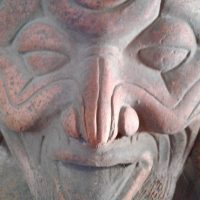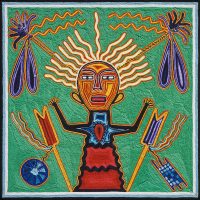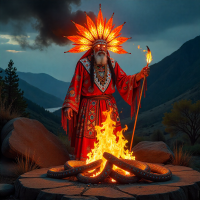Tatewari : The Eternal Grandfather Fire of the Huichol People
Listen
At a glance
| Description | |
|---|---|
| Origin | Huichol Mythology |
| Classification | Gods |
| Family Members | N/A |
| Region | United States of America |
| Associated With | Fire |
Tatewari
Introduction
Among the Huichol, or Wixárika, people of Mexico’s Sierra Madre Occidental, few deities command as much reverence as Tatewari, the Grandfather Fire. Considered the oldest of all gods and the origin of divine power, Tatewari embodies the sacred fire that gives warmth, cooks food, purifies the soul, and bridges the human and spiritual realms. More than a symbol of heat or light, Tatewari represents wisdom, transformation, and guidance—the living force that sustains both body and spirit.
In Huichol cosmology, fire is the eternal witness to creation. Every ritual, from the smallest household prayer to the great peyote pilgrimages, begins by invoking Tatewari. His flames are believed to communicate directly with the divine, carrying offerings and intentions upward to the heavens. As the first shaman, Tatewari remains a guiding force for all who seek healing, enlightenment, and harmony with nature.
Physical Traits
Tatewari’s form transcends human likeness, as his essence is expressed entirely through fire. During ceremonies, the sacred fire itself becomes his embodiment—its dancing flames, glowing embers, and rising smoke representing his living presence. He is not portrayed as a statue or idol but exists within the flicker of light and the warmth that radiates from the hearth.
In traditional Huichol art—particularly yarn paintings and beadwork—Tatewari is often visualized as a radiant, flame-enshrouded figure surrounded by symbols of energy and renewal. The colors red, orange, and gold dominate his imagery, capturing the vitality of fire and the cycle of creation. Shamans use feathered staffs and stones arranged around the ceremonial fire as tools to channel his power. Feathers serve as his messengers, bridging the realms of fire, air, and spirit, while serpents—especially coral and rattlesnakes—are considered his protectors, symbolizing transformation and regeneration.
Family
Tatewari’s familial role is symbolic rather than biological. As the “first ancestor,” he stands at the beginning of creation, predating all other gods. He is often associated with Takutsi Nakawé, the Grandmother of Growth, who complements his fiery energy with nurturing fertility. Together, they represent balance—the union of heat and growth, fire and life.
Although not a father or husband in human terms, Tatewari is a spiritual elder whose presence influences every generation of deities and humans alike. He serves as mentor to the divine messenger Kauyumari (the Deer Spirit), guiding him in the sacred peyote journey that connects the worlds. In this way, Tatewari is both the ancestral spark of creation and the ever-present counselor in the cycles of nature and worship.
Other names
Within Huichol tradition, Tatewari is widely known as “Grandfather Fire,” a name that reflects both affection and reverence. His title conveys deep respect for his age, wisdom, and the warmth he provides. Variants such as Tatéwari, Tatewarí, or Tatei Warí appear in different dialects and ceremonial chants, but all refer to the same eternal being.
In ritual contexts, shamans who act as intermediaries between humans and the gods may embody Tatewari’s spirit, earning the honorific “Mara’akame,” or shaman-priest. During peyote pilgrimages, the leading shaman symbolically becomes Tatewari, carrying his essence and invoking his power to illuminate the spiritual path. In this sense, the name “Tatewari” signifies not only the deity but also the sacred fire within each shaman who channels his energy.
Powers and Abilities
Tatewari’s abilities are vast, spanning creation, purification, protection, and spiritual transformation. His flame is the axis around which Huichol ritual life revolves. As the divine creator, he brought forth the other gods and established cosmic balance. His purifying fire burns away spiritual impurities, allowing participants in ceremonies to renew their connection with the sacred.
As the patron of shamans, Tatewari provides guidance during visions and healing rituals. He illuminates the hidden paths of the spirit world and protects travelers from malevolent forces. His warmth symbolizes compassion and sustenance, while his flame represents enlightenment and rebirth.
In Huichol agricultural traditions, Tatewari’s power manifests through controlled burning of fields to prepare for planting—transforming old vegetation into fertile soil. This act mirrors his cosmic role as a destroyer of stagnation and a creator of renewal. Myths also credit him with dividing the earth into five sacred regions, each governed by a deity, ensuring balance and harmony in the natural order.
Modern Day Influence
Despite external influences and modernization, the worship of Tatewari remains deeply embedded in Huichol identity. Fire continues to occupy the center of every ceremony, symbolizing the presence of their ancestral spirit. During rituals, shamans offer maize, tobacco, and feathers to the flames, speaking directly to Tatewari through sacred songs.
The annual pilgrimage to Wirikuta—a desert region in San Luis Potosí considered the birthplace of the gods—reenacts the original journey led by Tatewari. Pilgrims follow in his footsteps, seeking visions through the sacred peyote cactus. These traditions reinforce community bonds and preserve spiritual continuity across generations.
In contemporary times, Tatewari’s influence extends beyond religious ritual into Huichol art and activism. His image appears in vibrant yarn paintings and bead mosaics, which have become internationally recognized expressions of indigenous spirituality. Many Huichol activists invoke Tatewari as a guardian of sacred land, particularly in environmental movements defending Wirikuta from mining and ecological destruction. Through such expressions, the Grandfather Fire continues to burn—not only as a mythic force but as a living emblem of resilience, cultural identity, and ecological consciousness.
Related Images
Source
Lumholtz, C. (1902). Unknown Mexico: Explorations in the Sierra Madre and Other Regions. New York: Charles Scribner’s Sons.
Negrín, J. (1975). Huichol Mythology: A Study in Animism. Mexico City: Instituto Nacional Indigenista.
Benítez, F. (1968). La Peregrinación Huichol: Mitos y Ritos. Mexico City: Fondo de Cultura Económica.
Myerhoff, B. (1974). Peyote Hunt: The Sacred Journey of the Huichol Indians. Ithaca, NY: Cornell University Press.
Corelis, A. (n.d.). Symbolism used by the Huichols. Retrieved November 9, 2025, from https://www.mexconnect.com/articles/2769-symbolism-used-by-the-huichols/
Wikipedia. (2024, January 13). Tatewari. Retrieved November 9, 2025, from https://en.wikipedia.org/wiki/Tatewari
Flesh of the Gods: Peyote among the Huichol Indians of Mexico. (n.d.). Retrieved November 9, 2025, from https://samorini.it/doc1/alt_aut/sz/sampson_flesh-gods.pdf
Huichol Culture & Heritage. (n.d.). The Mountain Lion: Messenger of Divine Fire in Wixárika Culture. Retrieved November 9, 2025, from https://huichol.net/the-mountain-lion-messenger-of-divine-fire-in-wixarika-culture/
Furst, P. T. (1990). Flesh of the Gods: The Ritual Use of Hallucinogens. Waveland Press.
Neurath, J. (2013). Huichol Territory and the Mexican Nation: Indigenous Ritual, Land Conflict, and Sovereignty Claims. Journal of Latin American and Caribbean Anthropology, 18(1), 1–25.
Frequently Asked Questions
Who is Tatewari in Huichol mythology?
Tatewari, known as Grandfather Fire, is the oldest and most sacred deity of the Huichol people, representing fire, wisdom, and spiritual transformation.
What does Tatewari symbolize?
He symbolizes creation, purification, warmth, and the guiding light of ancestral wisdom central to Huichol spirituality.
How is Tatewari worshipped today?
Huichol shamans honor Tatewari through sacred fire ceremonies, offerings, and pilgrimages to Wirikuta, where he is invoked for guidance and healing.
What is Tatewari’s role in shamanic rituals?
He serves as the patron of shamans, guiding them through spiritual journeys and helping them communicate with other deities and ancestral spirits.
How is Tatewari represented in Huichol art?
Tatewari is depicted through fire motifs, radiant colors, and feather symbolism in Huichol yarn paintings and beadwork, representing his divine essence and transformative power.








